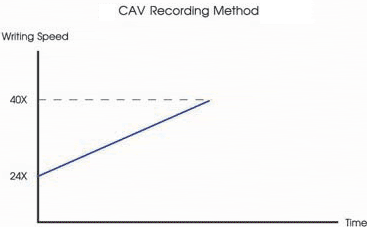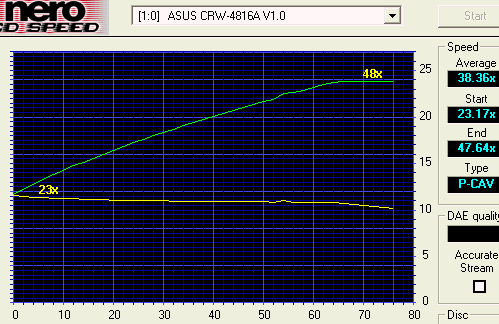ASUS CRW4816A
1. Introduction
ASUS CRW4816A IDE CD-RW - Page 1
The first 48x P-CAV recorder is here!
- Introduction
![]() The
race for achieving the highest ever recording/re-writing speeds has been something
that fascinates users and pushes manufacturers to adopt new technologies. After
the 40x recording speed category a new star rises up at 48x recording speed.
In order to achieve such high speeds, manufacturers adopt other technologies
than Zone-CLV. P-CAV and CAV are the answers for such speeds and ASUS is the
first manufacturer to offer not only CAV but also P-CAV 48x recorder among with
increased re-writing speed (16x) and fast reading (48x). What we can expect
from this proposal? Is really the ASUS CRW4816A the fastest writer, re-writer,
and reader with so many other 40x recorders around?
The
race for achieving the highest ever recording/re-writing speeds has been something
that fascinates users and pushes manufacturers to adopt new technologies. After
the 40x recording speed category a new star rises up at 48x recording speed.
In order to achieve such high speeds, manufacturers adopt other technologies
than Zone-CLV. P-CAV and CAV are the answers for such speeds and ASUS is the
first manufacturer to offer not only CAV but also P-CAV 48x recorder among with
increased re-writing speed (16x) and fast reading (48x). What we can expect
from this proposal? Is really the ASUS CRW4816A the fastest writer, re-writer,
and reader with so many other 40x recorders around?
- Features
 The
drive supports 48x writing (P-CAV), 16x re-writing (CLV), has a 2MB Buffer and
includes "FlextraLink", "FlexSpeed" and "DDSS II"
technologies. As ASUS explains:
The
drive supports 48x writing (P-CAV), 16x re-writing (CLV), has a 2MB Buffer and
includes "FlextraLink", "FlexSpeed" and "DDSS II"
technologies. As ASUS explains:
.![]() ,
prevents users from buffer underrun problems caused by an empty data buffer,
thereby eliminating the creation of unusable discs. Throughout the recording
process, FlextraLink consistently monitors the data buffer status
to ensure best recording quality. Once the available data drops below 1% of
the total buffer capacity, FlextraLink suspends the recording
and sets a marker at the last written position to avoid recording blocks. As
soon as enough cache data is refilled in, the pickup head repositions itself
to the marker and restarts the recording. FlextraLink uses minimal
system resources so the PC remains full operational and available for other
applications even during recording process.
,
prevents users from buffer underrun problems caused by an empty data buffer,
thereby eliminating the creation of unusable discs. Throughout the recording
process, FlextraLink consistently monitors the data buffer status
to ensure best recording quality. Once the available data drops below 1% of
the total buffer capacity, FlextraLink suspends the recording
and sets a marker at the last written position to avoid recording blocks. As
soon as enough cache data is refilled in, the pickup head repositions itself
to the marker and restarts the recording. FlextraLink uses minimal
system resources so the PC remains full operational and available for other
applications even during recording process.
 The
DDSS II is an enhanced follow-up to the first generation Double Dynamic Suspension
System developed by ASUS. The DDSS technology is designed to minimize the vibration
caused by the spindle motor and resonance between components as well as the
drive and PC cases. DDSS II makes tracking and focusing even more precise, and
successfully reduces the vibration and noise caused by high revolution of the
spindle motor.
The
DDSS II is an enhanced follow-up to the first generation Double Dynamic Suspension
System developed by ASUS. The DDSS technology is designed to minimize the vibration
caused by the spindle motor and resonance between components as well as the
drive and PC cases. DDSS II makes tracking and focusing even more precise, and
successfully reduces the vibration and noise caused by high revolution of the
spindle motor.
![]() enhances accuracy and reliability when writing/re-writing across a broad base
of certified media. It continuously monitors the recording media and sets the
optimal writing speeds to ensure best recording quality. The built-in proprietary
AI Auto Speed Adjustment Technology helps the driver function in the best status
when reading across a broad base of certified media in different formats. It
not only continuously monitors the reading media but also sets the optimal reading
speeds. The latter greatly saves power and prolongs driver's life.
enhances accuracy and reliability when writing/re-writing across a broad base
of certified media. It continuously monitors the recording media and sets the
optimal writing speeds to ensure best recording quality. The built-in proprietary
AI Auto Speed Adjustment Technology helps the driver function in the best status
when reading across a broad base of certified media in different formats. It
not only continuously monitors the reading media but also sets the optimal reading
speeds. The latter greatly saves power and prolongs driver's life.
The exact writing speeds are 4x, 8x, 12x, 16x (CLV), 24x, 32x, 40x and 48x (P-CAV). ASUS states in the retail box that the 48x writing speed is CAV, but our tests showed its P-CAV, even faster.
 The
re-writing speeds are 2x, 4x, 8x, 10x, 12x and 16x (CLV) and the maximum reading
speed reaches 48x (CAV). All known writing modes are supported (DAO, SAO, TAO
and RAW), overburning . Mt. Rainier is officially supported from ASUS with the
new drive and behind all these there is MediaTek's chipset that enable hardware
EFM correction.
The
re-writing speeds are 2x, 4x, 8x, 10x, 12x and 16x (CLV) and the maximum reading
speed reaches 48x (CAV). All known writing modes are supported (DAO, SAO, TAO
and RAW), overburning . Mt. Rainier is officially supported from ASUS with the
new drive and behind all these there is MediaTek's chipset that enable hardware
EFM correction.
Below are the specifications as found in the retail box. Notice that ASUS says 48x (CAV) while our tests showed 48x (P-CAV) recording technology:

- CAV vs. P-CAV
CAV features three main charateristics:
- Higher average recording speed
- Minimum recording time
- Constant motor speed throughout when writing data
CAV recording technology is also known as Full CAV. A CAV drive maintains a consistent rotation speed that results in different transfer rates. The linear velocity increases gradually as the read head move across the inner area of the disk to the outer area. A CAV drive also features minimum recording time and higher average recording speed.
The read head of a Z-CLV drive stops writing data, and buffer underrun happens every time when the motor changes speeds. Linking technologies, such as FlextraLink, BURN-Proof, JustLink, SafeBurn, to name a few, activates when buffer underrun occurs. On the other hand, no extra links will be produced during the recording process of a CAV drive that runs at a constant rotation speed, allowing a smooth transferal to higher speeds. Recording time is therefore greatly reduced, while average recording speed improves significantly.

P-CAV (Partial Constant Angular Velocity) Recording Technology
P-CAV recording technology is a cooperation of CLV and CAV that offers a stable and reliable way to record data. The transfer rate will continue to increases until the drive reaches its maximum writing speed, and then maintains a constant rate comparable to that of CLV technology. A P-CAV drive is considered by many to be an ideal solution for Audio CDs and pre-mastering a disk for mass duplication. The technology also brings stable recording quality since no links are produced during recording process.

- 48x recording speed
As we mentioned earlier, ASUS CRW-4816A is the first 48x recorder that supports not CAV but P-CAV. This implementation is probably faster than other 48x full CAV recording technologies. In the Nero graph chart, the green curve refers to the drive's transfer rate, while the yellow curve represents motor speed:

As Nero CD Speed reports, the drive starts writing at 23.17X and gradually reaches 48X speed at 66mins. The drive keeps that speed until the end of the disc. Using an 80min disc you maximize the average recording speed to 38.36X, which is the fastest, we measured in our labs. Note that this is the theoretical average recording speed. As our tests showed, the final recording times are not exactly the same as we were expecting.
Using various media, we witnessed changes in the average recording speed from 38.36X down to 37.98X:

The 40x (P-CAV) recording speed is also very fast with 35.75X average speed:














